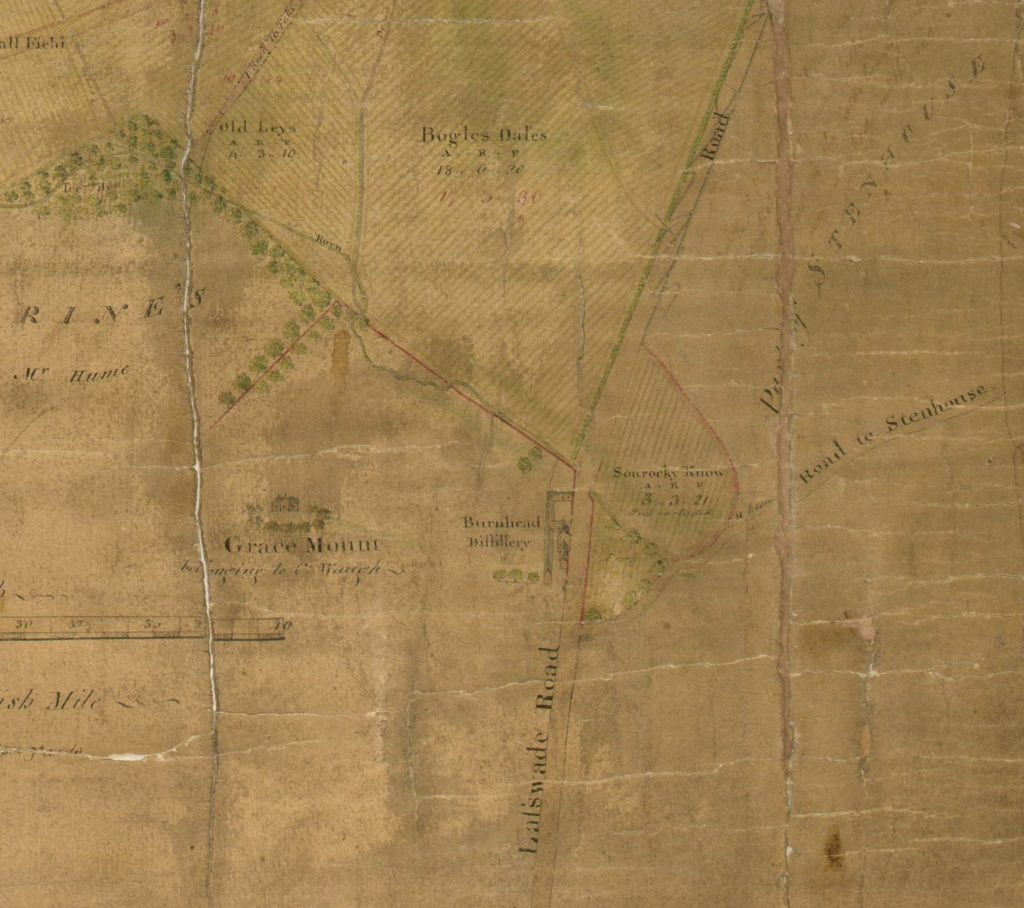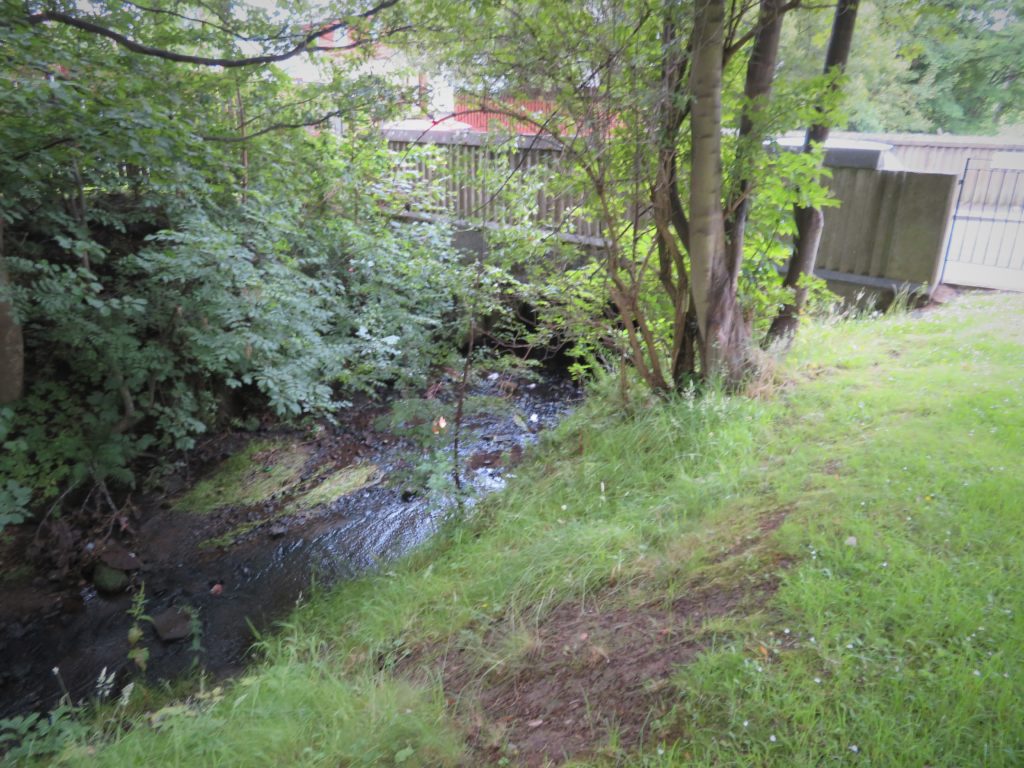
A study of the history of the south side of Edinburgh has revealed that a whisky distillery was established at Burnhead in the late eighteenth century on a site now under a modern development of flats almost opposite the Northfield House Hotel and next to the Lasswade Road. We understand that planning permission was granted in November 2021 to demolish the Northfield in order for the building of Student Accommodation.
The distillery building was illustrated in a survey plan of the land and property of Mr William Charles Little Gilmour of Liberton, produced in November 1794 and deposited in the Craigmillar Papers held by the National Records of Scotland (NRS) at General Register House. The illustration of the building on the plan seemed to indicate ownership by the Gilmour Family in this mapping. However no trace of such involvement has been found in the Gilmour papers or accounts. The Burnhead Distillery appears to be unknown.
A visit to the site found no trace of the distillery building remaining. The position of the building to the immediate south of a small burn took advantage of a constant water supply essential in the distillation process. The Lasswade Road offered easy access to product distribution by cart to Edinburgh and Leith. Further raw materials such as barley for malting and coal for the furnace were easily found within the adjacent estate lands. Local labour supply and essential skills such as a smithy and cooperage were locally obtained.
The research project first looked at the available maps. The first Ordinance Survey showed that the distillery building had vanished by the middle of the nineteenth century to be replaced by a building named as Gracemount Farm. An early map surveyed in 1766 by John Laurie shows three roughly square buildings placed differently on the site to the building illustrated on the 1794 Estate Plan. The earlier buildings were later identified from Court of Session Records, available online, as a brewery set up by George Colvin, a brewer possibly as early as the 1730’s. The Court of Session Records also revealed that from 1752 to 1761 the premises were operated as both a brewery and a distillery by a Mr Cleghorn, the distillery pot having a capacity of 130 gallons.
The Court of Session Records indicated no activity on the site from that date to the new development in 1790 which appears marked on the Estate Plan. A search of records at the (NRS) found that a series of account books and related documents in the collections for the Burnhead Distillery which covered the period July 1790 to April 1793. The name of the distiller was Andrew Stein.
Andrew Stein was a member of the great and numerous Stein family. The Steins together with their neighbours the Haigs dominated the Lowland Scottish distillery industry in the 18th and early 19th centuries. They were the great innovators of 18th century Scottish industry, building an early canal, a railway and a port facility in support of their great distillery at Kennetpans, the largest distillery in Scotland at the time of building. The Steins particularly were the fathers of the large scale modern whisky export industry of today. The Stein family are reputed to have settled in Scotland from Holland in the 12th century, farming land by Clackmannan near Kennetpans on the river Forth. The family history and numerous achievements of the Stein family are to be found described in detail on the internet site of the Kennetpans Trust set up to record and preserve the remaining buildings of the Kennetpans Distillery.
The commercial activities of the Steins and their Lowland distilleries were very successful but depended on the regulation of the industry by a series of Acts passed in Parliament. The Wash Act of 1784 was designed to promote the regulated (taxed) production of Whisky and Gin in the Lowlands of Scotland. Production surged and a growing percentage of the London Gin market was served by the Lowland distilleries through spirit shipped out of the Forth Ports by the Steins and Haigs which was then converted to gin in London distilleries.
In 1786 the alarmed London gin producers being priced out of the market lobbied Parliament and the result was the passing of the Scotch Distillery Act which together with further legislation in 1788 required the Lowland Distilleries to pay for a special licence to export spirit out of Scotland and to wait for twelve months before being able to recommence the exports to London. The Act forced many of the Lowland Distilleries out of business into bankruptcy and closure. Into this dislocated market stepped Andrew Stein who set up at Burnhead a small distillery, with a single copper still of 119 gallons capacity.
The Burnhead accounts give an interesting picture of how such a distillery operated. Amongst the first entries in July and August were payments for a government licence which was paid in advance twice a year and amounted to £252.16s.11d annually. This amount rose slightly for the second year. The tax was a large amount on the debit side of the business that enabled Burnhead to trade around the Edinburgh district. The numerous illegal distilleries did not have to bear such a handicap and dominated aqua production in Scotland. Throughout the time of operation the price of the aqua delivered from Burnhead was between 2s.7d and 3 shillings per gallon. Simple arithmetic shows that it would take about 2000 gallons of aqua to be sold to bring in the years licence fee without allowance for costs incurred as overheads, or any necessary profit.
The accounts show that labourers at Burnhead were paid 6s per week, a shilling per day allowing for a day off on Sunday. Early purchases made at the start of the enterprise were a furnace door for 10s.6p, a thermometer for 12s.6d and coal for the furnace at 5s.6d per cart load. Barley was also bought by the bol an old measure for grain roughly equal to a modern 200 litres. The first purchase was 112.5 bols of barley with a greater quantity of ready malted barley also purchased to speed the first distillation.
The sales records show a local spread of purchasers who seem from the size of the orders to be to suppliers of Whisky to licenced drinking premises of which there were many, with possibly few individual purchasers for just home consumption.
The aqua was sold in barrels of various sizes and transported by horse and cart. An account entry records £12.14.3d for the horses expenses, shoes etc. Sales recorded in the accounts include a number to Mr George Armour of Gilmerton who was the best customer of the Distillery. Mr Smith of Liberton purchased 138 gallons for £19.11s and Mr W McQueen of Nether Liberton 34 gallons, early purchasers. Customer lived as far away as Biggar with a number just listed as being resident in districts within the City of Edinburgh.
Throughout all the documents relating to the distillery there is no mention of the word whisky the distillery product being referred to as aqua short for aqua vitae, Latin for water of life.
Production and sales continued into 1791 then an action for “Nuisance” was taken out against Andrew Stein by Patrick Miller owner of Southfield, a house and estate a short distance east of Burnhead, downstream of the burn that supplied water to Burnhead Distillery. The action was taken to the Court of Session and a transcript can be seen online. Patrick Miller stated that the Distillery was discharging brown polluting water and foam with a “nauseous stench” into the burn that served

the Southfield Estate. An immediate serious difficulty for Andrew Stein was that the Court ordered that the Distillery be shut down under a legal interdiction before the start of their consideration of the case. The interdiction continued through the hearing and remained in place after the verdict, which in general was not favourable to Andrew Stein, though the last line of the hearing stated that arbitration would settle the matter. There was no further indication of how long that process or when or if the interdiction was ever lifted.
Within the evidence given in the court hearing were interesting comments pertaining to the early history of the site. Stein affirmed that the Burnhead site had been used for about sixty years as a brewery and distillery. Stein introduced extracts from the Collection Book of an Excise Officer that showed the site operating from 1752 to 1761 as both a brewery and distillery. In 1752 the distillery operated a still of about 130 gallons capacity under a Mr Cleghorn. If Stein’s first assertion was right a brewery at least would have been working at Burnhead possibly from the 1730’s, though the site had been abandoned for years before Andrew Stein acquired the property for redevelopment.
The action for “Nuisance” was a considerable financial blow to the Distillery, the Licence to operate and other overheads had still to be paid whether producing or not. The Distillery accounts examined continued up to April 1793 after which they ceased.
There are no further records found except a paper dated April 1794, a sequestration meeting was held by the creditors of Andrew Stein in the house of Robert Lawson an innkeeper of Cowgate to recover debts owed relating to Burnhead Distillery. Bankruptcy and legal actions were a feature of the Stein’s business experience and throughout their history the family members exhibited a resilience in business and financial adversity.
Andrew Stein survived bankruptcy and emerged to acquire Hattonburn Distillery in 1795. By 1825 he had moved on to Kirkliston Distillery forming a partnership known as Stein and Allan. In 1827 this became Andrew Stein & Co and in 1828 Andrew Stein died. The Company became bankrupt in 1831.
David J Hughes,
Greater Liberton History Group
October 2019
Sources
- Craigmillar Papers, with thanks to Sir David Gilmour